A Landscaped Musical Parking Garage In Chicago
Earlier this month I noticed an interesting parking garage in the block east of where we were staying on a weekend in Chicago, it was both landscaped and musical…
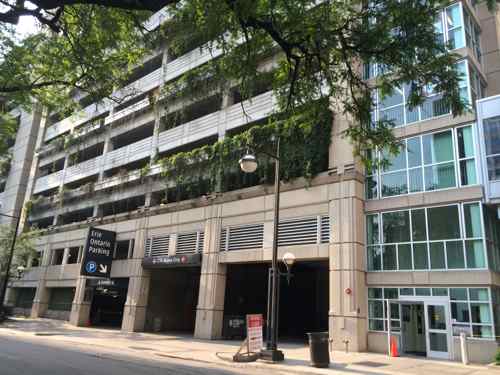
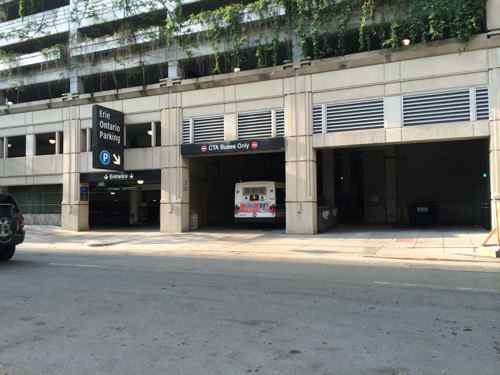
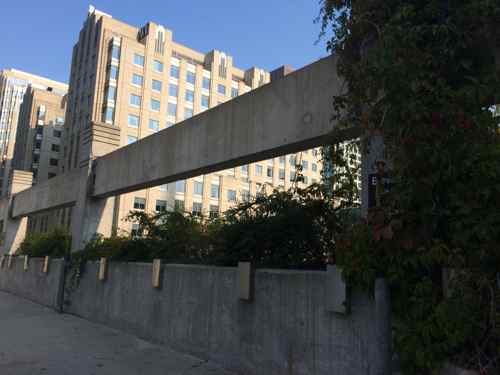
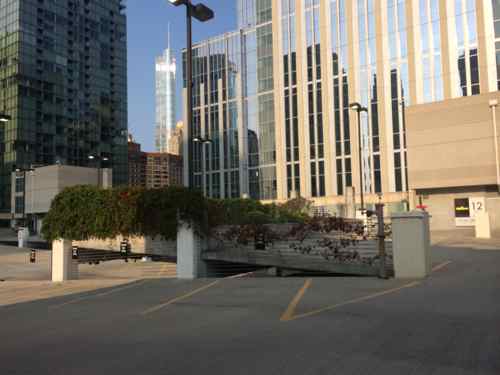
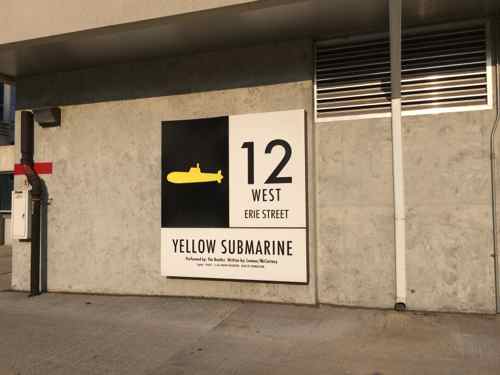
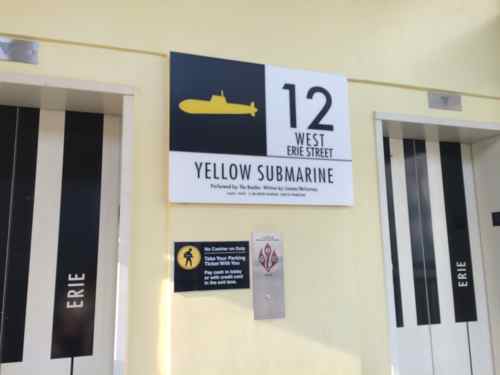
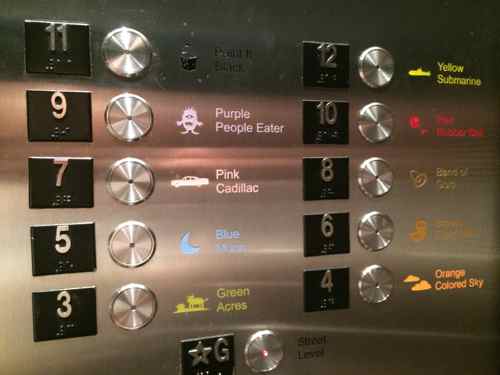
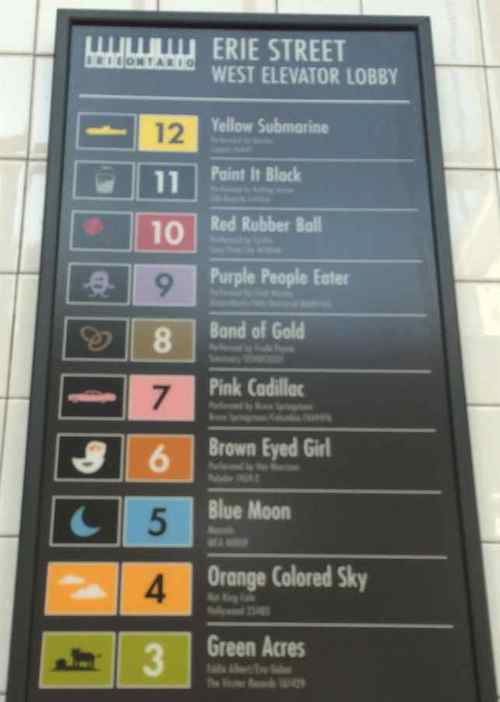
Here’s a list of the songs for each level (links to Wikipedia):
- 3) Green Acres
- 4) Orange Colored Sky
- 5) Blue Moon
- 6) Brown Eyed Girl
- 7) Pink Cadillac
- 8) Band of Gold
- 9) Purple People Eater
- 10) Red Rubber Ball
- 11) Paint It Black
- 12) Yellow Submarine
If you’ve ever returned to a garage and forgotten where you parked your car, you’ll appreciate the songs. You just might have Purple People Eater in your head all day.
— Steve Patterson
The real question is how much they are charging for parking, and were you entertained?
Erie Ontario Parking Garage
Address: 321 E. Erie Street, Chicago, IL
Rates (Effective 7/3/13):
Up to 30 min.: $15.00
30 min. – 1 hr.: $20.00
1 hr. – 2 hrs.: $27.00
2 hrs. – 3 hrs.: $31.00
3 hrs. – 4 hrs.: $36.00
4 hrs. – 24 hrs.: $42.00
At $42 a day, I personally would expect something a little more. Dinner and a show maybe?
Thanks for posting, we paid the same in the building where we parked on the next block west. $84 for 48 hours.
Its been awhile since I paid to park in downtown Chicago and I remember thinking at the time that $24 a day was outrageous. At these rates I would be curious to know if people are cutting back on parking their car an using more mass transit?
They are, and a lot more are riding bikes, as well.
Oh yeah. TONS use alternate transit — whether using the el or buses within the City or the many heavy-rail passenger lines run by Metra to service the region. It’s kind of amazing/beautiful.
With that said, there’s still PLENTY of people who drive in an park, and the rates of garages reflect that. I’m for it! A parking space isn’t a civic right, and if there’s a cleaner, more sustainable system available, those that want to use the other form *should* pay a premium.
I’ll say this — I live in Chicago now and absolutely love the transit system. Not having a car, I can get basically wherever I want (and that includes many suburbs/”rural” areas) with minimal delay and only the lighter pre-planning.
When I lived in Edwardsville and worked in St. Louis, I STILL didn’t have a car, and it was easy enough…but I lived (intentionally) two blocks from the E’ville transit center and worked in the heart of downtown STL. Getting anywhere else was much more difficult.
I think it’s got to be a conscious effort on St. Louis’ part to make transit a viable option. Part of that will be removing parking minimums, reducing parking maximums and improving the e-w/n-s system for buses and trains.
I’ve been enjoying their transit system on all three visits this year. The urban nature of Chicago supports transit.
The fundamental differences between Chicago and St. Louis are geographic and economic. Chicago has a very strong grid system of streets and a strong downtown, while St. Louis has more of a radial system, focused on a weak downtown. Transit, here, serves one, struggling, employment center fairly well, while most other employment and shopping centers receive just token service. In Chicago, transit serves both a strong downtown AND connects multiple, thriving, neighborhoods outside of downtown.
Yes, “it’s got to be a conscious effort on St. Louis’ part to make transit a viable option.” But I disagree that governmental regulation is at the core of the problem. I’d argue that low parking prices, here, are a direct result of low demand for other uses of the land. When it’s cheaper to tear an existing building down to create surface parking (as is the case in most St. Louis neighborhoods), than it is to occupy the structure with a productive human use, it doesn’t matter what the “rules” say. Conversely, when it costs people $42+ a day to rent 30 square feet to store a vehicle ($500+ / square foot, annually!), then Economics 101 starts to kick in. People choose transit when it works better, for them, than driving – when it’s cheaper, almost as convenient and almost as comfortable as driving.
The bigger issue is much bigger than zoning in the city. The bigger issue is the continued movement by middle class workers, with both their jobs and their residences, OUT of the city. When you live in Wentzville or Warrenton and work in O’Fallon or St. Peters, it doesn’t matter what the city’s parking regulations may be. Chicago has managed to both keep their downtown relevant and thriving and to make many of their formerly-ethnic urban neighborhoods cool places to live (the south side being a huge exception). People need to WANT to live, work, shop and party in an area to create enough financial disincentives for abundant, cheap parking and to create enough ridership for frequent, “good” public transit. We’re starting to see some increased demand in a few parts of St. Louis (primarily the CWE / central corridor), but not nearly enough to drive up parking costs or to drive significant numbers of drivers to give up their cars.
St. Louis used to have a very strong grid, but we totally trashed it over the last 50-60 years. After another Chicago visit I’ll do a post comparing the BJC hospital complex to the Northwestern campus/hospital. Night and day difference bashed on what I’ve seen my last two visits.
Yes, St. Louis’ large employment centers definitely have a “complex” configuration issue — rather than fitting within multiple blocks of publicly-accessible streets, the trend has been toward removing public streets to form more of an office park vibe, often fronted or encircled by employee parking.
Great point with Northwestern. A massive complex, but it barely disrupts the street grid there in downtown/Streeterville. But that can happen when the city has historically negotiiated from a position of strength. In St. Louis over the last half-century, the City hasn’t done that.
Yeah – what were the parking rates? And who owns the garage? If it’s the university or the CTA, they both have the resources, and likely a mandate, to subsidize these amenities. Don’t get me wrong, I like the concept and the implementation, but how does it transfer to the real world?
Plants require watering. Planters require frequent watering. Unwatered plants look worse than hubcaps hanging on the side of a parking garage! And then plants tend to die-out in the winter. Planters also tend to provide convenient waste dumps for patrons who want to get rid of “stuff”! Ask anyone on an evening cleaning crew at any shopping mall. Strange things end up in planters: soiled diapers, sanitary napkins, rancid spaghetti from the food court. Plants might work well in Santa Monica, San Diego or on the big island, but I wonder how practical they are in Chicago, STL, KC, Indianapolis or Des Moines. The musical theme is cute–like hubcaps!
The planters have an irrigation system
It’s “The Beatles”. Not “The Beetles.”
Thanks, I intended to verify the spelling but forgot.